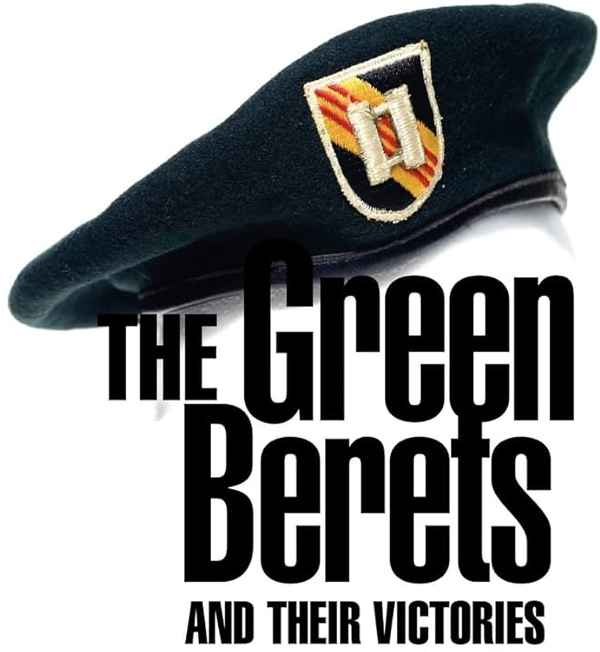
CHAPTER THREE, Section A
II CORPS AND THE BATTLE TO SPLIT VIETNAM Part III
By Joseph Patrick Meissner
From The Green Berets and Their Victories, Chapter Three, published by Authorhouse, November 21, 2005, pages 90-98, reprinted with permission.
The second crucial episode I wish to relate—another crisis that threatened Camp Duc Lap—began immediately after the first.
After a new perimeter had been established, the camp leaders discussed the situation back at the TOC. They all agreed that if reinforcements did not arrive soon, the camp could not hold out. Boody, the team sergeant, was on the radio all morning telling this to Lieutenant-Colonel Reed at Ban Me Thuot. Two companies of Pleiku Mike Force were still camped less than 1500 meters from camp on the heights to the northwest.
Reed also had two companies of Nha Trang Mike Force waiting on the airstrip at Ban Me Thuoc. These could be lifted into the Duc Lap area by helicopters. Reed ordered the Pleiku units to advance. At the same time, be directed the Nha Trang companies to move to Duc Lap by helicopter.
These reinforcements, however, seemed very distant to the defenders on the southern hill of Camp Duc Lap. Most of the “A”-team had gathered in the TOC to discuss what to do. The NVA had completely encircled the camp and were pulling the noose tight.
“The enemy was up within hand grenade range of the perimeter,” Harp said later. “They were real close. We had to bring napalm air strikes within eighty meters of our lines. In fact, that’s what had started the flight up the hill when one bomb hit short among the soldiers. We were screaming to higher headquarters to get us some help.”
Boody discussed plans for leaving camp with his team members. The route of escape would be down the southwest corner of the hill by the motor pool, then out through the coffee plantation. The enemy was thought to be weakest at this point. Moreover, the rescuing Mike Force companies were approaching the camp from this direction. Thus the camp survivors would be able to link up with a friendly force. Shepherd, the medic, got some thermite grenades from the team house and these were passed around, two to an American, so that the mortars and other camp weapons would not be left intact for the enemy to use. (In early May 1954 at Dien Bien Phu, the defenders had made similar plans for a break-out through the Viet Minh encirclement.)
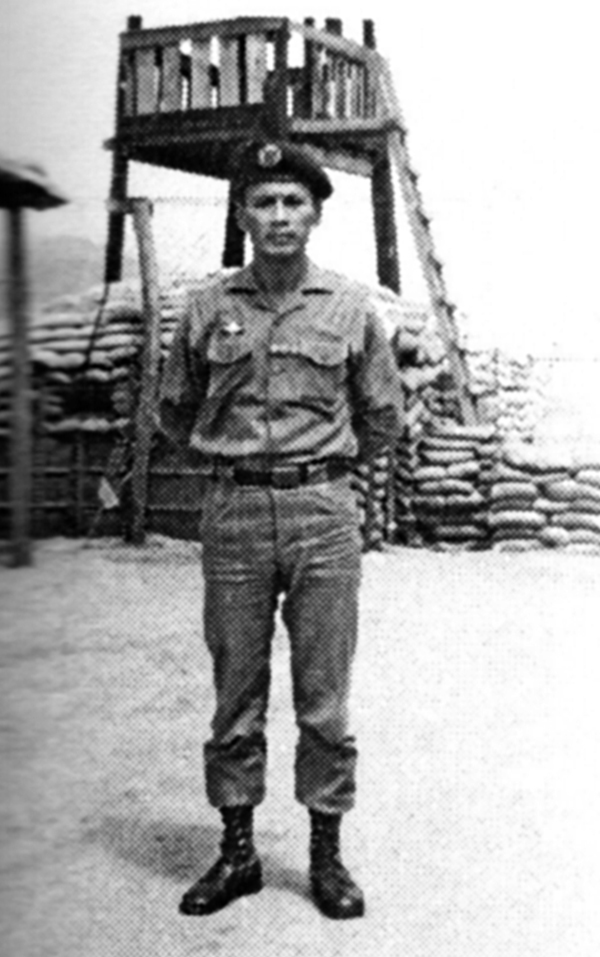
Very impressive VNSF commander whose Vietnamese team successfully assumed complete operation of an A-Camp in I Corps. The Green Beret Mission was to turn over all of their camps to VNSF.
The hardest part of the plan concerned the two Americans who had been wounded in the prior days of fighting. Neither could walk, both were in constant pain. Little hope existed that either could be carried out the camp if it was overrun. One, Major Roland Greenwood, was given a pistol and an M-16. Propped up in one corner he kept his weapon pointed at the door. The other, Sergeant First Class Harry Umeda, had his .45 out and held it across his chest. Neither man was going to be taken alive. (I know it sounds corny, but the story of the Alamo and Colonel Jim Bowie comes to mind.)
None of these plans were conveyed to either the VNSF or the Montagnards. “I don’t know how we would have gotten the troops and their dependents out,” Shepherd confessed after the battle. Perhaps that was justification enough for not informing them. Such a discussion would only have thrown them into a state of panic and would have lessened their chances for survival.
Childs had returned to the TOC about 1000 hours and reported to Boody and Harp that the perimeter was secure. Impatient with all the talk about leaving the camp, he picked up a radio and headed back to the northern slope of the main hill. Below the inner wire were a number of bunkers nestled against the side of the hill. Childs figured that during the earlier confusion, the enemy had probably seized these bunkers and was still there.
“I had a plan,” Childs related later, “to retake these bunkers and put some Yards down there, so when Charlie came up the hill that night we’d have an early warning system. We could stop him before he got within the inner perimeter. After this I was going to go back by the VNSF building near the gate. A sandbag wall was there and one bunker. I was going to take the bunker apart, rebuild the wall, and put a .30 caliber there as a strongpoint to cover this whole area of the hill.”
The VNSF medic, Sergeant Le Van Lai, called “bac-si” or “doctor” in Vietnamese, came over to talk to Childs about the bunkers below the hill.
“He was something of a cowboy with a permanent sneer on his face,” Childs said later. “He wore his hair long beneath his ears. One of the indig had told me this guy was a damn-good fighter, that he knew karate, and could beat the hell out of anybody. About average size, maybe a little stocky, he looked a little funny when he smiled since a couple of his front teeth were missing.
“I originally didn’t think much of this man. From seeing him around the camp I thought he was like most of the other slopes—just generally sorry. But my opinion really changed. This man was definitely a brave man. He didn’t run when the Yards ran, when the shit got pretty deep. He was exceptionally brave, in fact a hell of a lot braver than I.”
The Vietnamese medic had somehow captured a complete enemy B-40 rocket and launcher. He had fired this into one of the enemy bunkers in the saddle blowing it up.
Childs rounded up ten CIDG. Loading up with grenades and a LAW, he and the bac-si led their tiny force down the road toward the bunkers. The American fired the LAW and blew up the first bunker on the right. Its roof was level with the road, so Childs simply rolled on top and began to make his way to the far side.
‘’As I crawled over, I came upon an unexploded grenade,” Childs remembered. “I could see the Yards cowering just outside the innermost gate. I yelled at them to come on. But I knew it was mine and bac-si’s show all the way. The Yards weren’t going to do anything. Even the combat interpreter I had wasn’t much help. He barely got past the gate. He had the radio. I gave it to him with orders to call back if I got hit and get somebody down there to rescue my ass. I knew Shepherd would be down, at least I hoped so.
“I crept over to the far side of the bunker roof and came to a shooting port. There was an AK-47 sticking out, waving around. So I pulled the pin on my grenade, put it behind me, let the hammer fly, waited a couple of seconds, then dropped it in there. Bac-si threw a grenade in the other side. The grenades went off and blew that fucker to pieces.”
Darting sideways to the left of the first bunker which Childs had destroyed with the LAW, both men demolished a couple more bunkers with grenades. Then crawling down the slope into the saddle, they looked for more game.
‘’All this time we were under sporadic automatic weapons fire and sniper fire from the far slope. Suddenly the firing increased. It was coming not only from the enemy hill but also the gully. I had about ten brown cornstalks, half an inch in diameter, for protection. I lay on my back and side with my feet down the hill, watching what was going on. Bac-si was about ten feet from me doing the same, cooling it.
“Glancing back up the hill, I saw the Yards who were supposed to be with us but who hadn’t gone past the first bunker, making it back up the hill. They had left bac-si and myself down there, with no grenades, just our personal weapons.
“In front of us about fifteen feet was a shell hole. Three Charlies poked their heads up, two with AK-47’s, and started toward us. I switched my M-16 to fully automatic and shot at them. I hit one. His whole head just disintegrated. I assume I killed or wounded the other two because I didn’t see anything more of them.”
“Then bac-si and I started back up the hill. I laid down covering fire and he would move, then he would fire and I would move. It was slow going. On the way we spotted two B-40 rockets and launchers, laying off to the side. But because of the intense fire we couldn’t get them. Besides we were already loaded down with weapons we had picked up from the dead in the bunkers.”
The results of two men’s efforts were two bunkers demolished, three cleaned out, and at least five enemy dead. They had also dragged back three AK-47’s and three rocket launchers. One of the Yards took the AK’s and fired them at the enemy. Childs, however, was still determined to go down the slope again and finish the job he had started. Moreover he wanted to get those two other rockets and launchers left behind so they could not be used against the camp.
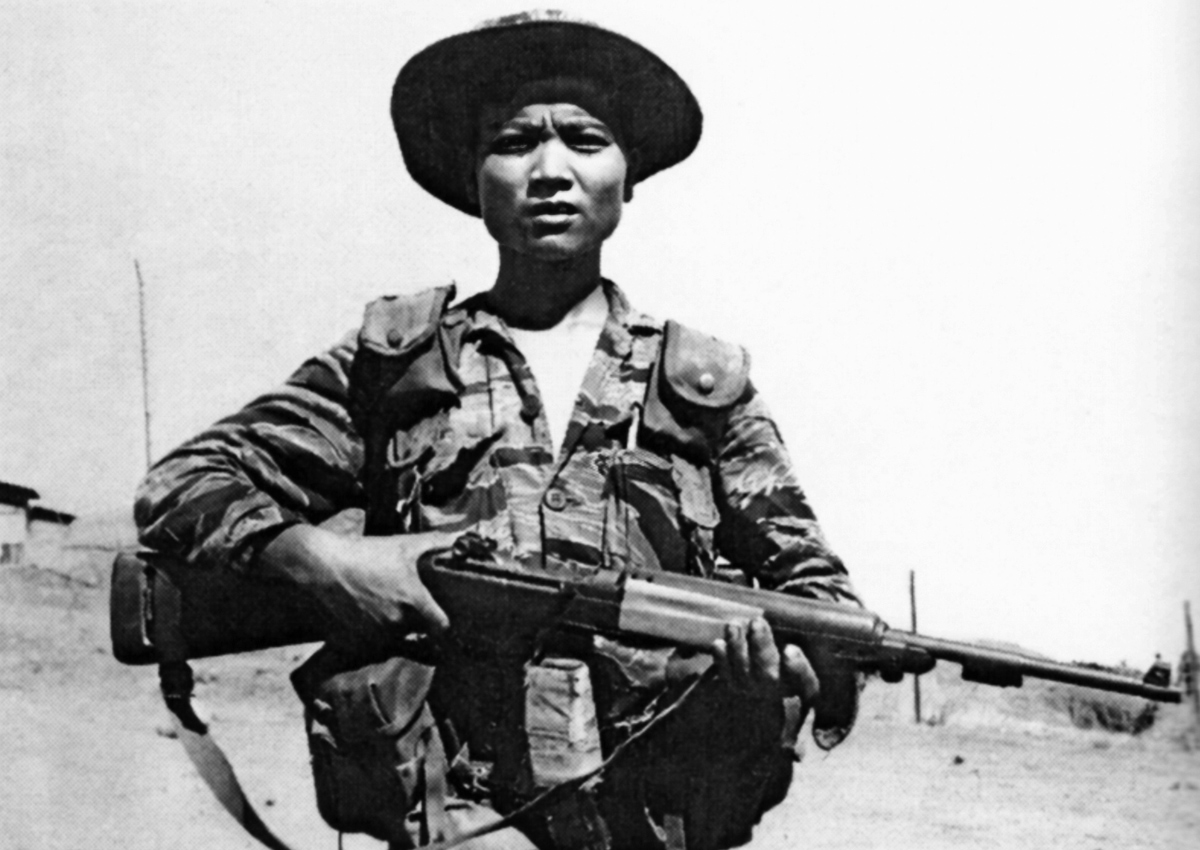
This “gutsy” CIDG company commander has already been awarded an American Bronze Medal for his bravery and fighting skills.
“I asked for ten brave men to come down the hill with me,” Childs went on. “We were going to try all over. Not surprisingly, ten brave men didn’t step forward. So bac-si and I went back down the hill alone to retrieve those two B-40’s. I had just reached the rockets and was ready to pick them up. Bac-si was on the other side of the two launchers behind a pile of rubble. We had been under fire all this time, but now it really became intense. It was fantastic. Bullets were everywhere. I tried to hide in a ditch behind a mound of earth. I couldn’t quite reach the rockets. Bac-si tried but he couldn’t get them either. I decided this just wasn’t worth our lives.”
Childs looked over at the medic. Both knew they had to get out of there.
“Come on,” Childs yelled, “we’ll get them later.”
Then the American jumped up and in a broken field run dashed back up the hill. Bac-si turned over and rose to his knees to follow the scrambling Beret. Suddenly a burst of gunfire hit him in the back and he collapsed in the reddish dirt, his fingers clutching the side of the hill.
“When I got up the slope,” Childs related, “I saw bac-si still laying there. I thought he was getting a slow start or just afraid to come up. I yelled for him a couple of times. I had the interpreter shout down. But he just lay there, rolling around a little. I assumed he was wounded.”
Childs radioed the TOC. Boody answered. A few other team members had come in to take a break and get something to eat. They listened to the conversation.
“This is Childs,” the voice came over the radio. “Where the hell have you been?” Boody asked.
‘’I’m down here on the forward slope. Look, the Vietnamese bac-si’s been hit.”
“All right,” Boody replied, “just stay where you are. Okay?”
Childs turned coward the interpreter. “You get those Yards to fire away and cover me.” He then ran back down the hill.
“When I got to bac-si, I found he had a hole in his back through the lungs, a sucking chest wound,” Childs described. “I pulled out my morphine and tried to give him an injection, but I wasn’t able to. I couldn’t get the thing to work right. I think I was worried about myself and I couldn’t get the scuff to come out. I couldn’t get over him to place a piece of plastic on his wound. Every time I moved I received automatic weapons fire. We were both pinned down.”
Childs tried to spot who was shooting at him. About twenty yards away in the gully was a green clad figure with his head and chest sticking up.
“I thought it was a dead body because this guy was really chubby, bloated like a corpse sitting around a while. But I couldn’t figure why he was sticking up like that. All of a sudden his head started to move. He was definitely well-fed. I suppose he was trying to find out what the fuck the story was. I got off a couple of shots at him, but I don’t think I hit him. I saw the bullets pinging around him.”
Childs had to get the wounded man back up the hill. “I tried pulling but he gave me no help whatsoever. He just looked at me and spit blood out his mouth. I dragged him about ten feet. Bullets skipped all about the ridge and slope. I just knew I wasn’t gonna’ be able to make it with him and it didn’t look like any help was coming. So I ran back up the hill.”
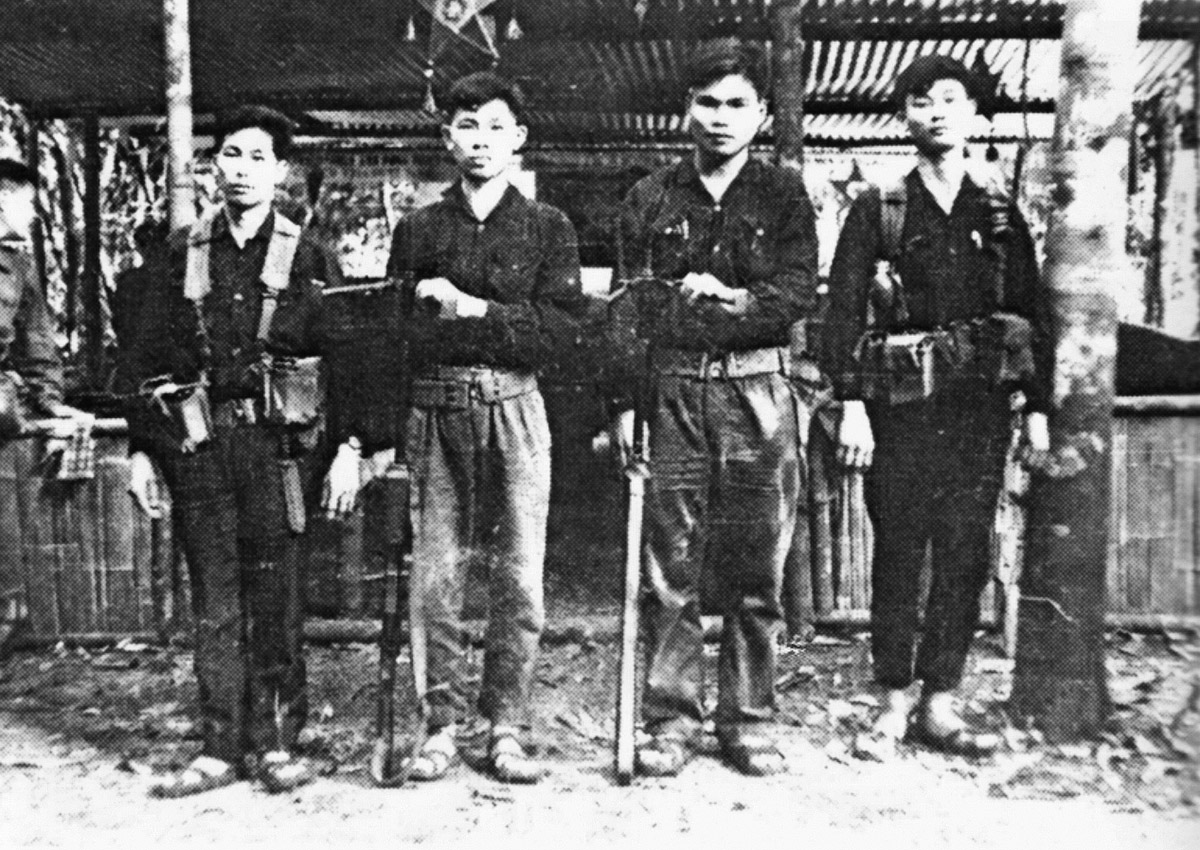
Captured Viet Cong film shows enemy soldier in jungle hide-out.
Childs pleaded with the Yards to come down and help. But none of them would. Up above he saw some jets circling, waiting to be called on. Childs radioed the TOC.
“This is Childs.”
“Where in the fuck have you been?” Boody yelled again over the radio at the youth. “If I get my hands on you, I’ll choke you. I’m ordering you to stay where you are.” Boody had known Childs before at another ‘’A”-camp. They had had a run-in there.
“He’s a big overgrown kid,” Boody said later. “He had been a real problem-child. Any other time and I would have court-martialed him. I could have killed him. I just knew he was going to get himself killed. He only had a few days to go and I didn’t want him to take any chances. Maybe he’s really growing up now, not completely, but about seventy-five percent.”
“Okay, okay,” the youth answered his fatherly top sergeant, “I can’t get bac-si. I can’t get him. He can’t move. The Yards won’t move either. I’ve got to go back.”
“If he’s really hurt and can’t get up, look,” Boody advised, “no sense in losing your own life.”
Lieutenant Harp, the A-Team leader, grabbed the radio. “Look, Childs, get your ass back in the perimeter.”
“Okay, no sweat, only six days to go,” Childs said. “Some TAC Air’s upstairs. Can you get them to come in and make a strike right down the saddle?”
The jets then swooped down in their first pass but the bombs dropped over on the opposite hill.
“Tell the bastards to bring it in closer, closer,” Childs yelled over the radio. He wanted the enemy to keep their heads down while he tried to rescue the little medic again.
A second time the jets roared down and unloaded more ordnance, but still not where Childs wanted.
“Tell them to bring the fucking things in, bring them in, bring ‘em in,” Childs screamed at Boody and Harp.
The jets made four or five passes, but none of them pleased the demanding youth.
“Fuck it,” he finally said as the last jet vanished to the east. Taking off all his gear except for the pistol belt and .45, the youth decided to try again. Everybody back at the TOC knew what Childs was going to do, knew that he was about to get himself killed, and knew there was no way to stop the youth. An order would have been silly.
One thought kept running through his mind, though, “Childs, you stupid shit, if you go down there again, you’re going to get fuck-up killed.” But, too late, his legs were already churning down the hill.
“I got down there and began to drag the groaning man again. Bullets were skipping all around. I pulled him back up to the road by a little ridge. Fire was really intense.”
The bullets danced up and down the road, just beyond the ridge. Childs watched for a few seconds, trying to catch his breath for a last effort. “But I was physically exhausted,” he confided later. “No way in hell could I have dragged bac-si up that road. I looked around for cover. A log lay there that bac-si had originally knocked over and used for protection when we came down the hill before.”
The youth rolled the wounded man behind the log and tried to make him comfortable. Then he dashed back up the hill to get help. First he asked the Montagnards to get some rope. “I thought I could go down and tie the rope around the man and drag him back up.” But no rope was available.
Next idea. “The Yards had some smoke grenades. I went over to the .30 caliber. The guy who was on the thirty, I don’t know if he knew how to shoot it but every time he tried, it would jam. So I grabbed it away from him. Then I told the interpreter to tell two of the Yards in the bunker by the gate to go down and pick up bac-si. I would throw the grenades to shield them, then fire the .30 caliber for cover. At first they didn’t want to go, but I used some pretty strong language and more or less talked them into to doing it.”
Childs threw the smoke grenades down between the enemy and the wounded Vietnamese medic. The smoke drifted back up the hill as perfect concealment.
“I fired while the two Yards ran down and dragged bac-si back up the hill until they were just outside the front gate. I kept firing at the enemy, then turned to look back. The Yards weren’t there anymore and bac-si was just laying in the middle of the road. I asked the interpreter where these two guys were. He said they told him they weren’t going to carry the body anymore. So I fucking dropped the thirty, ran out, grabbed the body, and carried him back inside the perimeter.” Childs then called the TOC.
“I got bac-si! I got bac-si! I’m bringing him up.”
A couple of the Montagnards helped the American carry the Vietnamese up to the team house. Childs, the indomitable, walked down into the TOC happily waving the B-40 rockets he had just captured.
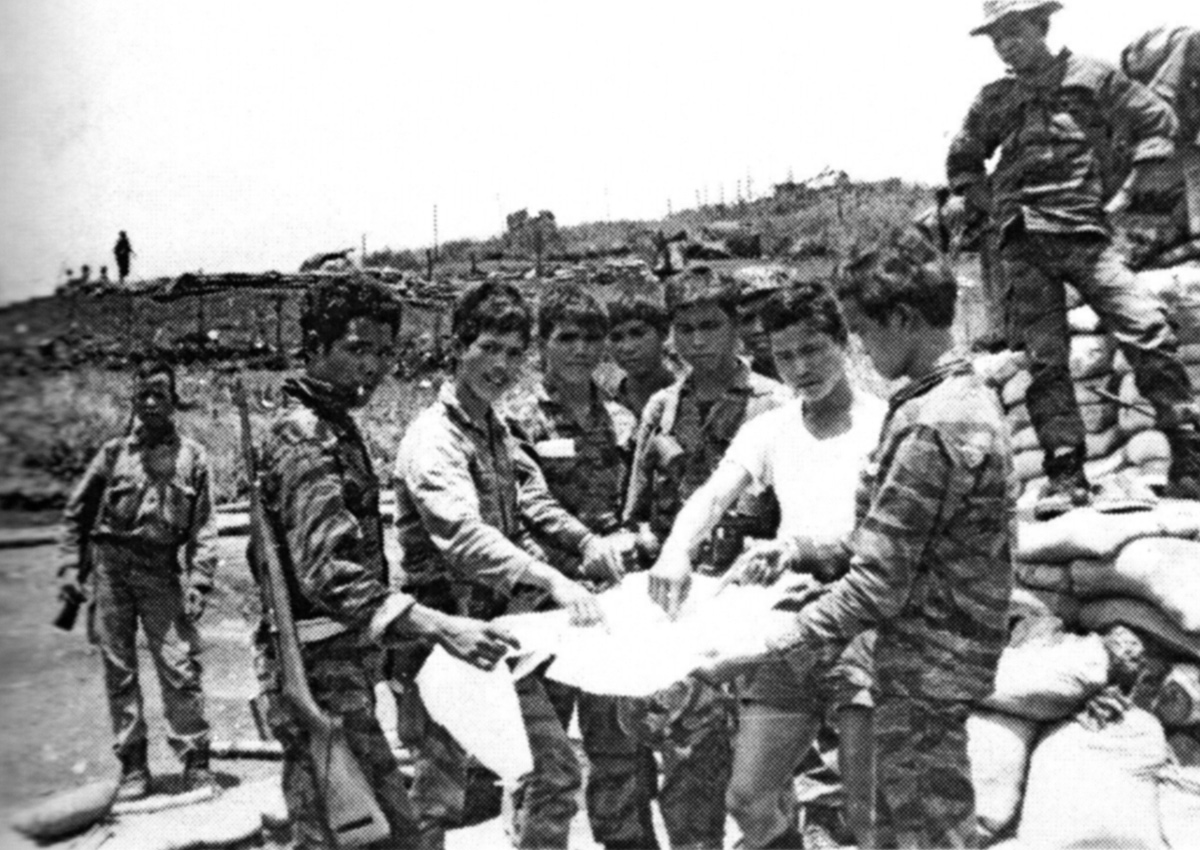
CIDG at Duc Lap SF camp show on the map where they destroyed the invading NVA.
“Get these fucking things out of here ,” Boody yelled at him. Somebody took the weapons outside to disarm them.
Meanwhile the wounded man had been laid on a piece of tin as a stretcher. Shepherd led the way into the medical bunker. He shoved an IV into the man’s arm and gave him a shot of morphine. The bac-si smiled a little and his missing teeth showed. He was all right.
Thirty minutes later this hero died from his wounds.
What had Childs and the bac-si accomplished in this second episode? Some weapons had been captured. Some enemy were dead. Several bunkers had been destroyed or cleared. But the camp defenders were unable to reoccupy these bunkers. This would cost the Pleiku and Nha Trang Mike Force companies dearly that afternoon when they assaulted the northern hill and drove the enemy out of Duc Lap. (This bloody five hour battle by the Mike Forces to recover the northern hill of the camp deserves a book in itself.)
So the question stands: What had Childs and the bac-si accomplished?
“They did a remarkable job,” Boody said after. “They pushed Charlie back and took the pressure off us. Charlie thought we had had it.”
What Boody may really have meant is that the American “A”-team thought they were finished. The plans to leave, the desire not to tell the VNSF or indig about such plans, passing out thermite grenades to destroy the camp’s heavy weapons, a wounded Major propped in a corner with his weapon facing the door, a sergeant holding his .45 caliber pistol across his chest, the desperate pleas for help—all these were signs of defeat. Ashau, Lang Vei, now Duc Lap? Another Special Forces camp overrun? No, not at all, a lanky overgrown American kid and a cowboy Vietnamese medic—Special Forces brothers—had attacked the enemy and restored the spirit of the camp.
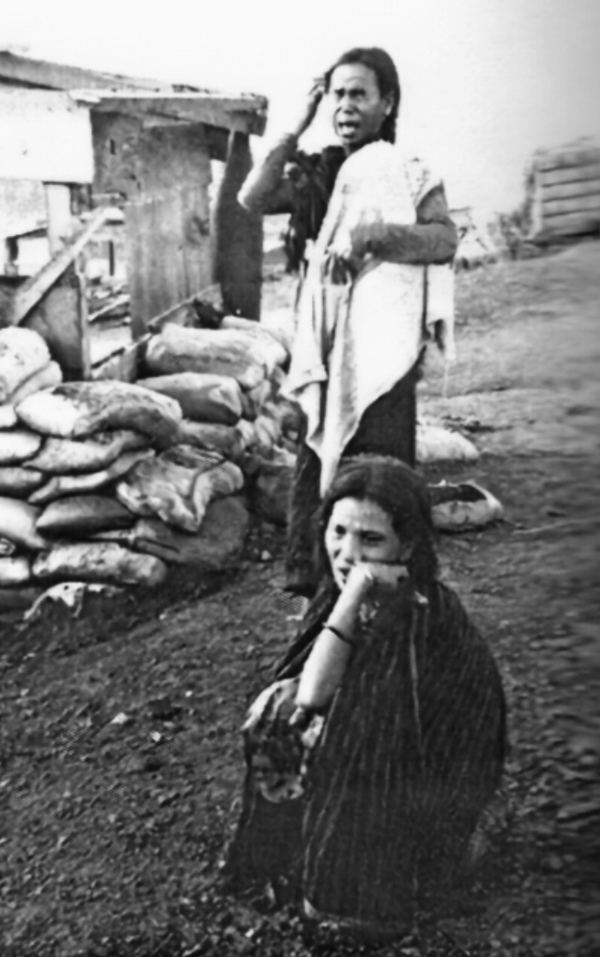
Leave A Comment